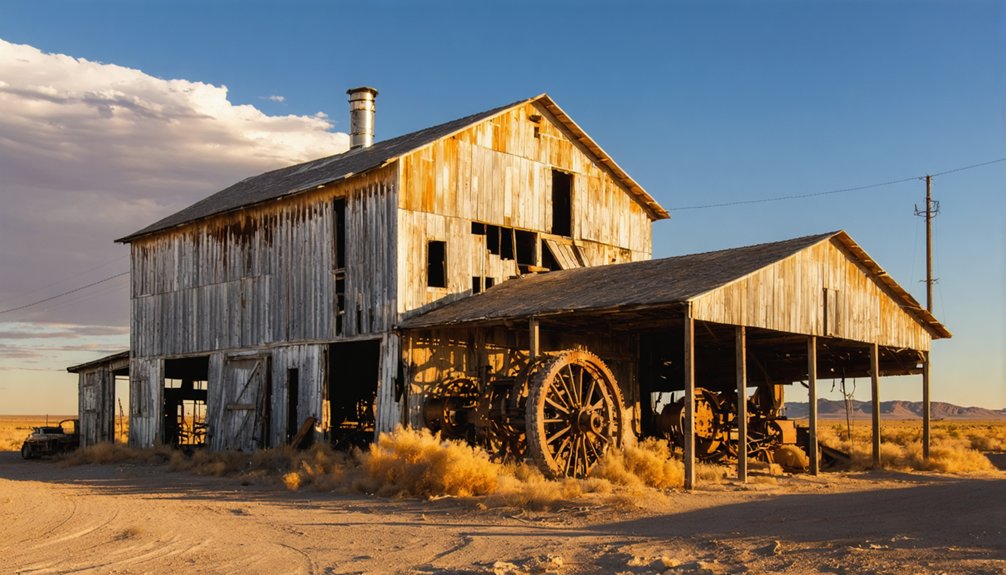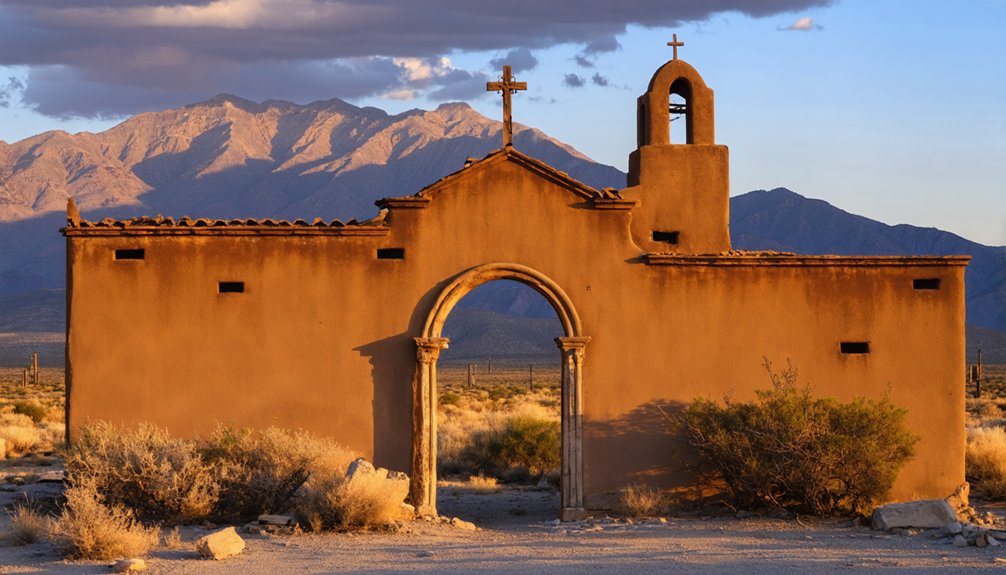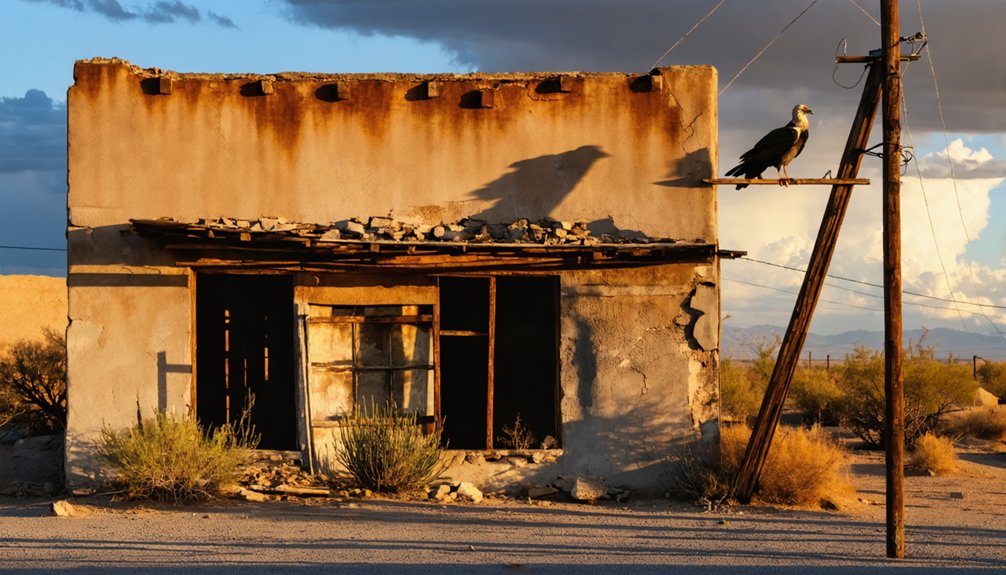You’ll find Ruidosa, Texas in Presidio County along the Rio Grande River, where it emerged as a cotton farming settlement in 1914. The community thrived initially with a cotton gin and irrigation project, while the Sacred Heart Church, built in 1915, served as its cultural center. By the mid-20th century, labor shortages and market challenges led to its decline. Today, this ghost town‘s adobe ruins and historic church tell stories of borderland resilience and adaptation.
Key Takeaways
- Originally established as cotton farming community in 1914, Ruidosa declined after World War II due to labor shortages and market challenges.
- The Sacred Heart Church, built 1914-1915 with massive adobe arches, remains the town’s most significant architectural landmark.
- Post-cotton era, the town transitioned briefly to vineyards before becoming a ghost town with few remaining residents.
- Located near the Rio Grande at 2,600 feet elevation, Ruidosa faced persistent challenges from harsh desert conditions and water scarcity.
- Preservation efforts focus on saving the historic adobe church through grants and community engagement led by Friends of Ruidosa Church.
The Spanish Penal Colony Origins
Although commonly misattributed to Spanish colonial efforts, Ruidosa’s earliest recorded settlement was actually a Mexican penal colony called Vado Piedra, established around 1824.
Located in a remote stretch along the Rio Grande, this penal colony served Mexico’s dual purpose of isolating prisoners and securing its northern frontier.
You’ll find the historical significance of Vado Piedra in its role as an early attempt to establish a permanent presence in this contested region.
The settlement faced constant challenges from Comanche and Apache raids, while its isolation made basic survival difficult.
The harsh desert environment and limited resources ultimately prevented the colony from flourishing, much like the nearby community of Casa Piedra which was established decades later in 1883.
Despite Mexico’s ambitious plans, no permanent structures from this period remain, and the site was largely abandoned by the late 19th century, though the area would later support a population of 300 during its brief peak in the early 1900s.
From Cotton Fields to Ghost Town
Long after the penal colony’s abandonment, Ruidosa found new life in 1914 when cotton farming families settled the area.
You’d have seen a cotton gin built that same year, followed by Esteban Ochoa’s irrigation project in 1917 that helped expand production along the Rio Grande.
But you can’t fight nature forever. West Texas’s harsh climate and persistent dry conditions made cotton farming increasingly difficult. Like many farms across Texas, the crop-lien system kept local farmers trapped in cycles of debt through high-interest purchases at landowner commissaries. Mexican laborers became a significant part of the workforce, with wages around $1 per day.
After World War II, labor shortages hit hard, and market challenges pushed revenues down. You’ll now find many former cotton fields transformed into vineyards, as farmers seek better returns in grape production.
Today, Ruidosa’s cotton decline has left it a ghost town.
While the Misión del Sagrado Corazon still stands as a monument to busier days, the once-thriving cotton community has virtually disappeared.
Life Along the Rio Grande
At 2,600 feet above sea level, Ruidosa’s position along a dramatic bend of the Rio Grande placed it within a unique three-pronged oasis known as La Junta de los Rios.
Nestled in La Junta de los Rios, Ruidosa rises above the Rio Grande where three vital waterways merge into an oasis.
You’ll find this green ribbon of life cutting through the rugged Chihuahuan Desert, flanked by the Sierra Vieja and Chinati Mountains.
The river trade shaped life here profoundly, with the Chihuahua Trail and ox-cart routes connecting Gulf ports to Mexican markets.
While Comanche and Apache raids initially deterred settlement, brave settlers eventually established farms and ranches along the fertile riverbank. By the 1880s, the area became more secure after the Apaches were subdued and relocated to reservations.
Cultural exchange flourished as Mexican and Anglo-American communities developed side by side, sharing the challenges of frontier life.
The river’s waters enabled cotton farming by 1914, while a local mill and cotton gin supported the region’s agricultural economy. Today, like many areas along the Rio Grande, the region faces severe water shortages due to agricultural diversions and urban growth.
Desert Architecture and Adobe Heritage
Mud, sand, and straw formed the architectural backbone of Ruidosa’s most enduring structures. You’ll find this adobe craftsmanship exemplified in the Sacred Heart Church, built around 1914-1915, where thick walls and high archways seamlessly blend with the desert landscape.
The desert’s harsh conditions demanded sustainable building practices. You’ll notice how the two-foot-thick adobe walls naturally insulate against temperature extremes, while whitewashed surfaces reflect the scorching sun. This ingenious design served the community well until cotton gin closure in 1936 led to population decline. Local workers constructed these buildings with expertise passed down through generations.
Traditional vigas support roofs covered with earth or plaster, protecting inhabitants from the elements.
Today, you can witness preservation efforts by the Friends of the Ruidosa Church, who’re working to save this rare example of desert sustainability. Despite challenges of funding and location, they’re transforming this century-old adobe structure into a living embodiment of West Texas’s architectural heritage.
Sacred Heart Mission’s Legacy
Sacred Heart Mission emerged as a spiritual cornerstone in 1914 when Father Nicholas Brocardus Eekin, a Dutch-born circuit-riding priest, established it to serve the growing borderland communities of Ruidosa and Barrancos de Guadalupe.
The mission’s architectural significance shines through its massive adobe arches and distinctive twin towers, built entirely by local hands under Father Manuel Cuadrado’s guidance. The church became a vibrant community center hosting baptisms and weddings. The church was constructed using adobe bricks made by local citizens in 1915.
You’ll find evidence of deep community involvement in every brick, as residents crafted the adobe structure that became their social and spiritual hub.
Though the mission fell into disrepair by the 1950s, its legacy endures through preservation efforts.
Today, you can witness this heritage through cultural events and art installations, including the “Latido de Luz” sculpture, while the Friends of Ruidosa Church continues restoration work on this borderland treasure.
Natural Wonders of the Chinati Mountains
From Ruidosa’s crumbling adobe walls, you’ll see the dramatic 7,728-foot Chinati Peak rising against the Chihuahuan Desert sky, with its rugged cliffs and rocky slopes shifting from desert scrub to high-elevation grasslands.
You’ll discover hidden canyons where drought-resistant flora like cacti and brush thrive in the harsh terrain’s microhabitats, spanning a 4,400-foot elevation change.
Throughout the seasons, the volcanic formations showcase different hues as sunlight plays across the ancient trachyte and rhyolite surfaces that formed over 31 million years ago.
Majestic Desert Peak Views
Rising majestically above the Chihuahuan Desert, Chinati Peak dominates the landscape at 7,728 feet, offering spectacular 360-degree views of Texas’s rugged Trans-Pecos region.
You’ll find yourself surrounded by dramatic cliffs and brush-filled drainages as you ascend this distinctive landmark, where panoramic vistas stretch across rolling desert terrain and jagged mountain ranges.
From the broad, flat summit, you’ll witness the raw beauty of volcanic formations shaped over 35 million years ago.
The terrain below reveals a stunning array of terraced mesas and deep canyons, while high desert vegetation shifts from sparse grasses and cacti in lower elevations to hardy conifers and oaks near the peak.
You’re treated to unobstructed views of the Chinati Mountains State Natural Area’s 39,000 acres of pristine wilderness.
Hidden Canyon Flora Types
Deep within the rugged canyons of the Chinati Mountains, you’ll encounter a remarkable variety of desert-adapted flora thriving in this harsh environment.
You’ll spot the towering Yucca torreyi with its stiff leaves dominating the landscape, while Dasylirion leiophyllum (sotol) spreads its spiny rosettes across rocky slopes.
As you explore deeper, you’ll discover sacred datura stretching up to 8 feet tall in moister areas, alongside vibrant skeleton-leaf goldeneye adding splashes of yellow to the terrain.
The flora diversity extends to bear grass forming dense clumps on hillsides, perfectly adapted to the region’s volcanic soils.
These plants showcase incredible desert adaptations, from extensive root systems to thick, water-conserving leaves, all sustained by seasonal monsoon rains that bring life to these hidden canyons.
Seasonal Rock Formation Colors
Throughout the dramatic rock formations of the Chinati Mountains, you’ll witness an ever-changing palette of colors that shift with the seasons. The rich reds and rusty oranges you see come from hematite, an iron-bearing mineral that’s especially vibrant during dry periods. These seasonal hues intensify at sunrise and sunset, when warm light bathes the ancient volcanic rocks.
At elevations ranging up to 4,400 feet, rock weathering creates distinct color bands across the formations. You’ll spot deep reds in areas where monsoon patterns have influenced mineral development, while protected canyon walls display subtler tones.
The arid climate continually shapes these colors through oxidation and erosion, revealing fresh mineral surfaces that tell a story of geological transformation spanning 35 million years.
Exploring River Road’s Scenic Beauty
Along Texas Farm to Market Road 170, River Road beckons adventurous travelers with its stunning 115-mile route that parallels the Rio Grande River from Candelaria through Presidio to the edge of Big Bend National Park.
You’ll discover dramatic canyon vistas and stark desert landscapes unique to the Big Bend region, with scenic pullouts offering perfect spots for wildlife observation.
As you navigate the winding path, you’ll encounter the challenging “Big Hill” with its 15% grade, rewarding you with panoramic views of the Chisos Mountains to the east and Colorado Canyon to the west.
Watch for cattle, horses, and rare mountain sheep while exploring the limestone ridges and desert springs.
The road’s rugged character reveals a raw landscape where oak-juniper woodlands meet riparian ecosystems along the river’s edge.
Historic Cotton Industry Rise and Fall

In the early twentieth century, Ruidosa transformed from a modest settlement into a thriving agricultural community centered around cotton production.
You’ll find that pioneer Esteban Ochoa’s 1917 irrigation project revolutionized local cotton cultivation, leading to the construction of a cotton gin and supporting infrastructure.
The town’s golden age peaked in the 1920s and 1930s, with hundreds of residents sustaining themselves through cotton farming.
The adobe church, the largest building in town, stood as a symbol of the community’s economic sustainability and significance.
However, by mid-century, you’d have witnessed Ruidosa’s dramatic decline.
The construction of a dam in New Mexico, combined with severe drought and increased upstream irrigation, devastated the river flow.
Without sufficient water, cotton farming became impossible, forcing residents to abandon their homes and livelihoods.
Modern-Day Desert Dwellers
While Ruidosa’s cotton industry faded into history, modern desert dwellers in nearby regions face their own set of challenges.
You’ll find these resilient individuals adapting to extreme desert conditions through a combination of traditional knowledge and modern technology. Desert adaptation now relies heavily on air conditioning systems and sophisticated water management infrastructure to make life possible in harsh environments like Phoenix.
You can observe how desert communities maintain their freedom to live in these challenging landscapes through carefully designed canals and reservoirs that provide essential water resources.
Yet the struggle isn’t easy – many desert towns show declining populations, with aging residents and limited economic opportunities.
Modern desert dwellers must constantly balance their desire for independence against the realities of water scarcity and intense heat that shape their daily lives.
Preserving a Borderland Settlement

Today, dedicated preservationists are working to save one of the Big Bend region‘s most significant adobe structures – El Corazón Sagrado de la Iglesia de Jesús in Ruidosa, Texas.
The Friends of the Ruidosa Church, a nonprofit organization, leads this crucial preservation effort with support from the Texas Historical Commission and other partners.
You’ll find restoration techniques that honor frontier craftsmanship, including careful stabilization of the church’s bell tower and traditional adobe brick-making.
Community engagement thrives through volunteer workshops where you can learn adobe construction methods firsthand.
The organization’s secured $60,000 in preservation grants and is pursuing $240,000 in tax credits to fund ongoing work.
Following the Secretary of Interior’s Standards, they’re preserving this cultural landmark while maintaining its authentic character through historically accurate reconstruction of walls, doors, and the sacristy.
Frequently Asked Questions
What Precautions Should Visitors Take When Exploring Abandoned Buildings in Ruidosa?
With 85% of ghost town injuries linked to structural collapse, you’ll need safety equipment like helmets and boots. Check building stability before entering and don’t explore alone in Ruidosa’s abandoned structures.
Are There Any Camping or Overnight Accommodation Options Near Ruidosa?
You’ll find camping facilities at Terlingua RV Park, or book overnight rentals at Ruidosa Ghost Town Inn, Hot Springs Guest House, or Angell Expeditions’ school bus and Airstream accommodations nearby.
When Is the Best Season to Visit Ruidosa Considering the Desert Climate?
Visit in October-November or March-April when desert conditions are most favorable. You’ll enjoy moderate temperatures, clear skies, and minimal rainfall. The weather’s perfect for exploring without extreme heat or storms.
Does the Sacred Heart Church Still Hold Any Religious Services?
No, you won’t find any active religious services at Sacred Heart Church. Despite its church history and religious significance, it’s been inactive since the 1950s and is now preserved as a historic landmark.
Is a 4×4 Vehicle Required to Access Ruidosa’s Historic Sites?
While 4×4 trails aren’t mandatory, they’re strongly recommended. You’ll need at least a high-clearance vehicle for Pinto Canyon Road’s rough terrain, but standard vehicles can access some paved portions near town.
References
- https://texastimetravel.com/cities/ruidosa/
- https://www.westtexasleather.com/history-of-ruidosa-west-texas
- https://en.wikipedia.org/wiki/Ruidosa
- https://www.tshaonline.org/handbook/entries/ruidosa-tx
- https://www.texasescapes.com/TexasGhostTowns/Ruidosa-Texas.htm
- https://www.mgrosshistoricalchurches.net/sacred-heart-mission-ruidosa
- http://www.txgenweb.org/research/landmarks/presidio.htm
- https://en.wikipedia.org/wiki/Penal_colony
- https://texastimetravel.com/regions/mountain-trail/cities/
- https://services.austintexas.gov/edims/document.cfm?id=307020



